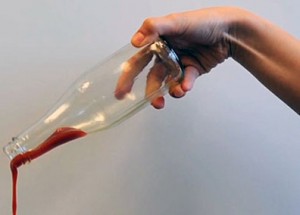The Condiment Conundrum: Solved?
-
-
slice.mit.edu
- 5
Filed Under
Recommended
 The secret to any great sandwich is its condiments. But what's the secret to actually pouring those condiments on the sandwich, without smacking the side of the bottle or shaking it up and down?
The secret to any great sandwich is its condiments. But what's the secret to actually pouring those condiments on the sandwich, without smacking the side of the bottle or shaking it up and down?Enter LiquiGlide, an MIT-developed lubricant that, when applied to the inside of bottles, makes pouring viscous liquids like ketchup, mayonnaise, and honey as simple as eating them and leaves the emptied bottle looking squeaky clean.
Fast Company has video of LiquiGlide in action, using ketchup and mayonnaise.
Selected as a wild card finalist for the 2012 MIT $100K Business Plan Contest, LiquiGlide finished second overall–out of a record 215 teams–and won the competition’s $2,000 Audience Choice Award, as voted by audience members via text messages.
The coating can be applied to glass and various types of plastic. Researchers behind the product are mum on the ingredients, but confirm that LiquiGlide was created using only non-toxic, FDA approved materials.
While the ketchup bottle conundrum seems more like a minor headache than a serious problem, the effects of an empty bottle could have far-reaching effects on the environment and the $33 billion food condiment industry.
LiquiGlide researcher Dave Smith told Fast Company:Developed in MIT’s Varanasi Research Group, The team includes doctoral students Smith, Christopher Love ’09, and Adam Paxson ’09; graduate student Brian Solomon; postdoctoral associate Rajeev Dhiman; and Associate Professor Kripa Varanasi SM ’02, PhD ’04.“It’s funny. Everyone is always like, ‘Why bottles? What’s the big deal?’ But then you tell them the market for bottles–just the sauce alone is a $17 billion market. If all those bottles had our coating, we estimate that we could save about one million tons of food from being thrown out every year.”
Described as “kind of a structured liquid…rigid like a solid, but lubricated like a liquid,” LiquiGlide has potential uses beyond food packaging. According to Smith, it was originally developed as a coating to stop oil and gas line clogs, and could potentially stop ice forming on various surfaces.








Comments
David
Thu, 07/19/2012 1:07pm
Video has been removed. :(
Jay London
Thu, 07/19/2012 1:36pm
Thank you David. The post has been updated with a link to working videos.
Frank Weigert
Wed, 07/18/2012 7:01am
"we estimate that we could save about one million tons of food from being thrown out every year.”
The food industry will be of two minds about implementing this.
On one hand, the first company to do so will create a halo effect for their product which could lead to increased market share. But if all producers use it, it will cost the industry the revenue generated by those million tons of food which are bought but not consumed.
philip richardson
Fri, 07/13/2012 12:04pm
How about a hull coating on sailboats. Can we get the America's cup back to Newport?
ruth winett
Fri, 07/13/2012 11:17am
Interesting